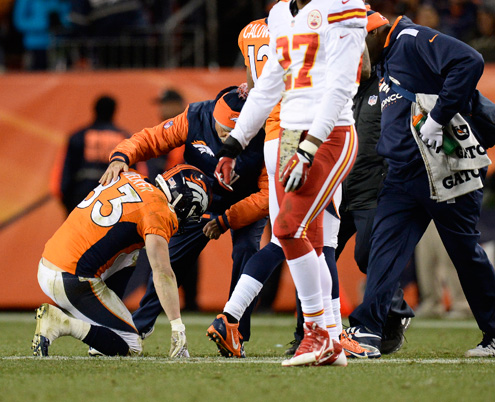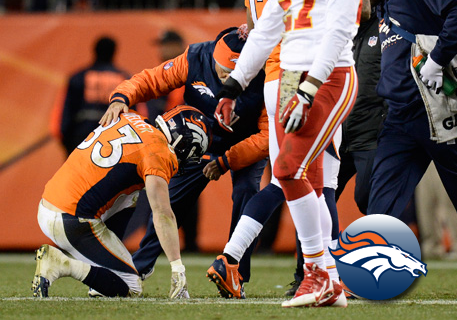
The big news from Saturday’s preseason action was the injury to Sam Bradford. The 26 year-old first overall pick of the 2010 draft has been plagued by ailments throughout his professional career, missing nine games last season with a torn ACL and six games in 2011 through various injuries.
But it is Wes Welker’s concussion in the Broncos’ 18-17 loss to the Texans that will have a bigger impact beyond the football field and the fantasy draft war rooms. This is already the third concussion that Welker has suffered since joining the Broncos in 2013. Alarmingly, adding last night’s brain trauma to those sustained in weeks 11 and 14 of last season, Welker has in fact endured three concussions in his last ten NFL games.
The NFL concussion lawsuit rumbles on, with ex-players receiving notices about a proposed settlement in advance of a fairness hearing on the 19th November. The lawsuit encompasses a class of approximately 20,000 former players and the settlement would mean that this class is finally provided with the medical testing and treatment it so desperately requires, as well as compensation to those that have suffered serious medical conditions subsequent to their playing careers.
However, this litigation is not over. A group of dissenters to the settlement are seeking to challenge it, with an appeal pending in the Federal Appeals Court. One of the most interesting and vocal dissenters is Sean Morey. Morey was a wide-receiver/special teams player in the NFL for four teams over the course of nine seasons. He was signed by the Seahawks as a free agent in 2010 but announced his retirement just before the team opened training camp. The reason: concussions.
His concerns are that the proposed settlement is grossly inadequate, particularly as it does not provide for a significant proportion of the class of players that have suffered from CTE. CTE is a degenerative brain disease that has been found in several deceased former players; most notably, Junior Seau, who committed suicide in 2012. There was also the case of former Bears safety Dave Duerson, who died of a self-inflicted gunshot wound to the chest in 2011. In his suicide note, Duerson asked his family to donate his brain to the Boston University School of Medicine. Under the proposed settlement, compensation is provided for the families of players that died with CTE, but only for the period between 2006 and 7th July 2014.
The NFL’s success as a business model is unrivalled in American sports. It continues to grow exponentially. Experience would say that such growth is not sustainable, and yet the league continues to prove otherwise. A great deal of the NFL’s success is attributable to its inimitable control over its image as well as its ability to be proactive and reinvent its game gradually over time to suit various objectives.
This brings us back to the case of Wes Welker. What would absolutely be harmful to the long-term future of the NFL is if more and more parents refuse to allow their children to play the game. The perpetuation of a negative perception of the NFL as representing a barbaric and archaic form of entertainment is also a concern for the league as it will begin to impact audience numbers. The NFL desperately needs a settlement of the concussion lawsuit to try and remove it from the public consciousness. Yet, with Welker, the issue is exacerbated.
It was noted by several members of the media that Welker’s speech was slightly slurred during his interview with Deion Sanders in the build-up to the Superbowl. Of course, this may have been an isolated incident and completely unrelated to any concussion issues. But what if it is not? What if we are seeing first-hand the slow but sure impact of years of taking brutal hits in the NFL? The jarring effect of actually witnessing this while a player is still in the league resonates with the public more because the sad reality is that once a player has retired we simply have less cause to think and care about them; the next generation has come in and they are the ones providing us with the games we need on a Sunday.
And there may be nothing that can be done about this. Welker’s size makes him an awkward target for defenses. Texans safety D.J. Swearinger, the man whose hit caused the concussion last night, contended:
“I led with my shoulder. That’s the only thing I could do. He’s a short guy.”
Then there is Welker’s style of play in tandem with his quarterback’s idiosyncrasies. As a slot-receiver, Welker is always used as a short-yardage option which makes him vulnerable over the middle to much bigger safeties and linebackers. His usual elusiveness in these positions made him an invaluable commodity to Tom Brady and Peyton Manning, with both quarterbacks famed for quick releases and efficient passes that keep the chains moving.
It has been evident over the past couple of years that engineers have been striving towards the development of a new helmet that will protect players more. Welker himself memorably wore a different and larger helmet model following his second concussion last season. The NFL has also been trying to handle the situation via rule changes and penalising dangerous hits with greater zeal. But for all the technology, rules and deterrents, it seems as though we are still some way away from a breakthrough.
This will be a fascinating situation to monitor throughout this season. Wes Welker is pivotal to the aspirations of the Denver Broncos and Peyton Manning. If Denver is going to replicate last season’s unprecedented success on offense, they will need to be able to utilise Welker in the same manner as always. But at what cost to Wes Welker? And at what cost to the NFL?
By Ognjen Miletic




